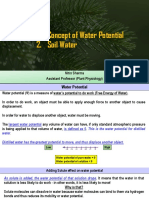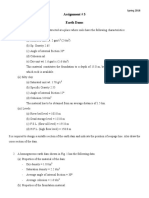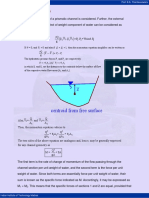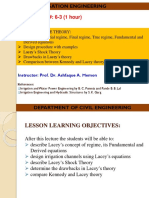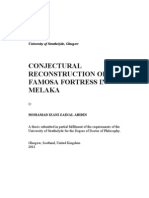100%(1)100% found this document useful (1 vote)
194 viewsLacey's Regime Theory
Lacey's Regime Theory
Uploaded by
Gaurav BalodiyaThe document summarizes Lacey's theory of irrigation channel design on alluvial soils from 1939. It describes Lacey's definitions of key terms like regime channel and rugosity coefficient. Lacey defined regime conditions and proposed that under constant discharge, silt grade, and silt charge, the dimensions, width, depth, and slope of a stable channel are fixed. The theory is based on field observations and empirical equations rather than strict scientific principles. The equations only approximately describe real-world conditions and regime states are rarely achieved in practice.
Copyright:
© All Rights Reserved
Available Formats
Download as PPTX, PDF, TXT or read online from Scribd
Lacey's Regime Theory
Lacey's Regime Theory
Uploaded by
Gaurav Balodiya100%(1)100% found this document useful (1 vote)
194 views7 pagesThe document summarizes Lacey's theory of irrigation channel design on alluvial soils from 1939. It describes Lacey's definitions of key terms like regime channel and rugosity coefficient. Lacey defined regime conditions and proposed that under constant discharge, silt grade, and silt charge, the dimensions, width, depth, and slope of a stable channel are fixed. The theory is based on field observations and empirical equations rather than strict scientific principles. The equations only approximately describe real-world conditions and regime states are rarely achieved in practice.
Original Description:
lacey's Regime Theory for Fluid mechanics it contains key points
Original Title
Lacey’s Regime Theory
Copyright
© © All Rights Reserved
Available Formats
PPTX, PDF, TXT or read online from Scribd
Share this document
Did you find this document useful?
Is this content inappropriate?
The document summarizes Lacey's theory of irrigation channel design on alluvial soils from 1939. It describes Lacey's definitions of key terms like regime channel and rugosity coefficient. Lacey defined regime conditions and proposed that under constant discharge, silt grade, and silt charge, the dimensions, width, depth, and slope of a stable channel are fixed. The theory is based on field observations and empirical equations rather than strict scientific principles. The equations only approximately describe real-world conditions and regime states are rarely achieved in practice.
Copyright:
© All Rights Reserved
Available Formats
Download as PPTX, PDF, TXT or read online from Scribd
Download as pptx, pdf, or txt
100%(1)100% found this document useful (1 vote)
194 views7 pagesLacey's Regime Theory
Lacey's Regime Theory
Uploaded by
Gaurav BalodiyaThe document summarizes Lacey's theory of irrigation channel design on alluvial soils from 1939. It describes Lacey's definitions of key terms like regime channel and rugosity coefficient. Lacey defined regime conditions and proposed that under constant discharge, silt grade, and silt charge, the dimensions, width, depth, and slope of a stable channel are fixed. The theory is based on field observations and empirical equations rather than strict scientific principles. The equations only approximately describe real-world conditions and regime states are rarely achieved in practice.
Copyright:
© All Rights Reserved
Available Formats
Download as PPTX, PDF, TXT or read online from Scribd
Download as pptx, pdf, or txt
You are on page 1of 7
Theory & Limitations
Taking lead from the Kennedy theory Mr.
Gerald Lacey undertook detailed study to
evolve more scientific method of designing
irrigation channels on alluvial soils. He
presented revised version of his study in
1939 which is popularly known as Lacey’s
theory. In this theory, Lacey described in
detail concept of regime conditions and
rugosity coefficient. The definitions of these
terms are already given.
Lacey defined regime channel as a stable
channel transporting a regime silt charge.
Regime conditions are as follows
1.The channel is flowing in unlimited
incoherent alluvium of the same character as
that transported.
2.Silt grade and silt charge are constant.
3.Discharge is constant.
Dimensions, Width, Depth and slope of a
regime channel to carry a given discharge
loaded with a given silt charge are all fixed by
nature.
Lacey gave three fundamental equations are:
V = 0.639 √fR
Where V is regime velocity
Af2 = 141.2 V5
V = 10.8 R2/3 S1/3
The Lacey’s work is based on field observations and
empirically derived equations and therefore it cannot be
said to be theory in strict sense.
Regime equations in their derived from cannot be applied
universally as they hold good mostly for the regions whose
data was taken for study.
Like Kennedy’s theory even though perfect definition of
silt grade and silt charge is not given most of the
equations are based on the silt factor ‘f’.
In practice regime condition stated by Lacey is very rarely
achieved and that too after a long period.
The field observations have shown limited acceptance of
the concept of semi-elliptical section of a regime channel.
Complex phenomenon of sediment concentration and
transport has not been scientifically considered.
1. 𝑓 = 1.76√𝑀𝑑
𝑄∗𝑓2 1/6
2. 𝑉= ( )
140
𝑄 𝐷2
3. 𝐴= , 𝐴=𝐵𝐷+
𝑉 2
4. 𝑃 = 4.75 𝑄 , 𝑃 = 𝐵 + 𝐷 5
𝐴 𝑉2
5. 𝑅= , 𝑅= 2.5
𝑃 𝑓
𝑓5/3
6. 𝑆=
3340∗𝑄1/6
You might also like
- Design Experiment Flow Rate Through A Sluice Gate Objective(s)Document4 pagesDesign Experiment Flow Rate Through A Sluice Gate Objective(s)Daniel VasquezNo ratings yet
- Tutorial On Seepage Flow Nets and Full Solution Chapter 1Document13 pagesTutorial On Seepage Flow Nets and Full Solution Chapter 1faraeiin57100% (2)
- 1877 PDFDocument8 pages1877 PDFAhmed AlbayatiNo ratings yet
- Comparison of Kennedy's and Lacey's TheoriesDocument1 pageComparison of Kennedy's and Lacey's TheoriesneelNo ratings yet
- Chapter 6Document26 pagesChapter 6Hailemichael ShibabawNo ratings yet
- Calculation of Band DrainsDocument3 pagesCalculation of Band DrainsWan100% (1)
- Khosla's Seepage TheoryDocument11 pagesKhosla's Seepage TheoryHemant ParmarNo ratings yet
- 3 - Design of Vertical Drop WeirDocument25 pages3 - Design of Vertical Drop WeirKesav kNo ratings yet
- CE341 CE22 Wk03 4 Soil CompactionDocument143 pagesCE341 CE22 Wk03 4 Soil CompactionFaiaz Bin DelworNo ratings yet
- Halim SirDocument133 pagesHalim SirMD Mazharul Islam BappyNo ratings yet
- Open-Channel Flow: (1) Introduction, Uniform Flow, Manning's Equation, Normal DepthDocument26 pagesOpen-Channel Flow: (1) Introduction, Uniform Flow, Manning's Equation, Normal DepthEmmanuel LazoNo ratings yet
- CE458 Chapter 5Document72 pagesCE458 Chapter 5Mihai MihailescuNo ratings yet
- Water Potential and Soil WaterDocument38 pagesWater Potential and Soil WaterManak ThakurNo ratings yet
- Earthened DamsDocument16 pagesEarthened Damsgopisrt100% (1)
- Spillways: 5.1. 5.2. General Formula 5.3. Sharp-Crested Weir 5.4. The Overflow Spillway 5.5. Broad-Crested WeirDocument17 pagesSpillways: 5.1. 5.2. General Formula 5.3. Sharp-Crested Weir 5.4. The Overflow Spillway 5.5. Broad-Crested WeirAlejandro GonzalezNo ratings yet
- Hydraulic JumpDocument15 pagesHydraulic JumpabbasjadoonNo ratings yet
- Evaluation of Vertical Superimposed Stress in Subsoil Induced by Embankment LoadsDocument9 pagesEvaluation of Vertical Superimposed Stress in Subsoil Induced by Embankment Loadscarlos moranteNo ratings yet
- Diversion Structures - Chap - 4 (Compatibility Mode)Document13 pagesDiversion Structures - Chap - 4 (Compatibility Mode)Refisa JiruNo ratings yet
- Lacey Design SheetDocument6 pagesLacey Design SheetEngr AhmadNo ratings yet
- Assignment # 3Document2 pagesAssignment # 3GEMPF100% (2)
- ED & HJ W.H.HagerDocument9 pagesED & HJ W.H.Hagerjamjam75No ratings yet
- Afflux & Loss of Flood Plain at BridgesDocument19 pagesAfflux & Loss of Flood Plain at BridgesannelcarrollNo ratings yet
- LESSON 10 Hydraulic JumpDocument9 pagesLESSON 10 Hydraulic JumpChandima K PriyamalNo ratings yet
- G2.11 Reservoir PlanningDocument16 pagesG2.11 Reservoir PlanningJenny Moreno100% (2)
- Slope Stability Analysis: Ordinary Method of SlicesDocument2 pagesSlope Stability Analysis: Ordinary Method of SlicesJuni PherNo ratings yet
- Principles of Dam Design Notes 1 - Design of Earth DamsDocument2 pagesPrinciples of Dam Design Notes 1 - Design of Earth Damsscelo butheleziNo ratings yet
- Chapter 5: Non Uniform Flow in Open ChannelDocument23 pagesChapter 5: Non Uniform Flow in Open ChannelShashank S100% (1)
- Manning Equation - Open Channel Flow Using Excel: Course ContentDocument40 pagesManning Equation - Open Channel Flow Using Excel: Course Contentmushava nyokaNo ratings yet
- How To Calculate The Specific Capacity of A Well - Ground WaterDocument13 pagesHow To Calculate The Specific Capacity of A Well - Ground WaterSATVINDAR SINGHNo ratings yet
- Canal FallsDocument8 pagesCanal FallsAli MohsenNo ratings yet
- Varying Peat in Sarawak and Some Geotechnial PropertiesDocument13 pagesVarying Peat in Sarawak and Some Geotechnial PropertiesSen HuNo ratings yet
- Discharge Coefficient DeterminationDocument5 pagesDischarge Coefficient DeterminationMansoob BukhariNo ratings yet
- BarrageDocument19 pagesBarrageusman javedNo ratings yet
- Lecture Notes 07Document39 pagesLecture Notes 07reem.ranoom.moon100% (2)
- Centroid From Free Surface: 9.1 Specific ForceDocument7 pagesCentroid From Free Surface: 9.1 Specific ForceSahil BhardwajNo ratings yet
- 6-3 - LaceyDocument16 pages6-3 - Laceywajid malikNo ratings yet
- Abdelhaleem - 2016 - Discharge Estimation For Submerged Parallel Radial GatesDocument6 pagesAbdelhaleem - 2016 - Discharge Estimation For Submerged Parallel Radial GatesBenjamín LagosNo ratings yet
- Hatem A. Ewea, Amro M. Elfeki, Jarbou A. Bahrawi and Nassir S. Al-AmriDocument34 pagesHatem A. Ewea, Amro M. Elfeki, Jarbou A. Bahrawi and Nassir S. Al-Amriayman_awadallahNo ratings yet
- Chapter 4: Basics of Dam Ancillary Structures 4.1 SpillwayDocument19 pagesChapter 4: Basics of Dam Ancillary Structures 4.1 SpillwayRefisa JiruNo ratings yet
- Chapter 2 - Lecture NotesDocument33 pagesChapter 2 - Lecture NotesĐỗ HoàngNo ratings yet
- Summary of Highway Design Loads: Appendix ADocument3 pagesSummary of Highway Design Loads: Appendix AJohn Rom CabadonggaNo ratings yet
- Canal Outlets&Modules Worked Out ExampesDocument34 pagesCanal Outlets&Modules Worked Out ExampesnambimunnaNo ratings yet
- OutletsDocument107 pagesOutletsHassan 62No ratings yet
- Stability Formula For Tetrapod Incorporating Slope Effect: Coastal Engineering Proceedings December 2012Document11 pagesStability Formula For Tetrapod Incorporating Slope Effect: Coastal Engineering Proceedings December 2012romeoremoNo ratings yet
- Numerical Problem:: A Concrete Gravity Dam Has The Following DimensionsDocument13 pagesNumerical Problem:: A Concrete Gravity Dam Has The Following DimensionsSehar ShahidNo ratings yet
- Pile Problem 1Document3 pagesPile Problem 1ReemALMousawiNo ratings yet
- Permeability and SeepageDocument9 pagesPermeability and SeepageJames Karl AluraNo ratings yet
- Open Channel Lectures Ahmed SaadiDocument40 pagesOpen Channel Lectures Ahmed SaadiحسامNo ratings yet
- Steel Structure AssignmentDocument11 pagesSteel Structure AssignmentGetaneh HailuNo ratings yet
- Conjectural Reconstruction of The A Famosa Fortress in MelakaDocument238 pagesConjectural Reconstruction of The A Famosa Fortress in MelakaIzani Zainal50% (2)
- CE 322 Assignment 1 - SolutionDocument13 pagesCE 322 Assignment 1 - SolutionNickson KomsNo ratings yet
- Phases Irrigation SystemsDocument8 pagesPhases Irrigation SystemsDanial AbidNo ratings yet
- 7 PermeabilityDocument76 pages7 PermeabilityB4-63-Harshit RajNo ratings yet
- Open Channel Depth Calculator Using VBADocument2 pagesOpen Channel Depth Calculator Using VBAmatt gramNo ratings yet
- A Comparative Study of Soil Slope Stability Under Seismic Loading ConditionDocument7 pagesA Comparative Study of Soil Slope Stability Under Seismic Loading ConditionG Kishore KumarNo ratings yet
- Assignment On Stability Analysis of Embankment DamsDocument15 pagesAssignment On Stability Analysis of Embankment DamshabtamuNo ratings yet
- Chapter No-02-GT2Document5 pagesChapter No-02-GT2VikasPatilVickyNo ratings yet
- Ecohydrology: Vegetation Function, Water and Resource ManagementFrom EverandEcohydrology: Vegetation Function, Water and Resource ManagementNo ratings yet
- 6-2 - LaceyDocument18 pages6-2 - LaceyyoyokhanyasirNo ratings yet
- IE Lec - 7Document8 pagesIE Lec - 7sa9088150No ratings yet












